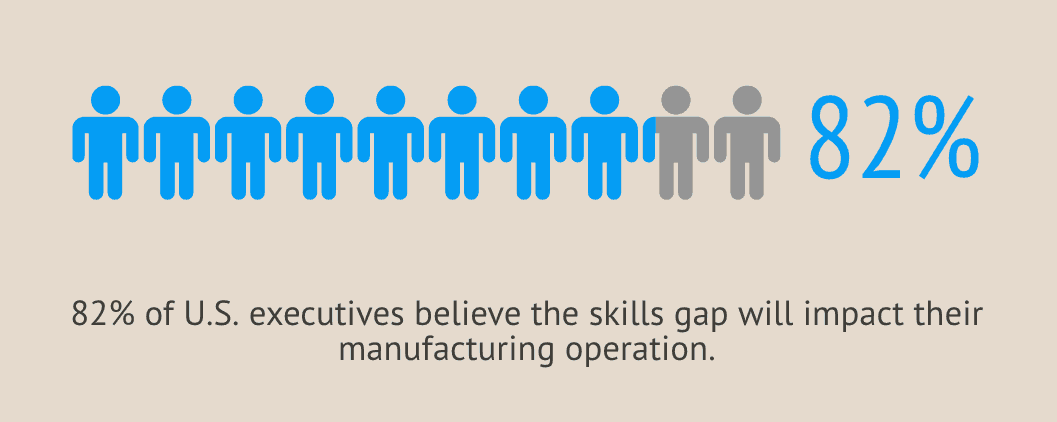What happens when your employees leave and there is no one to replace them?

 Increasing manufacturing jobs will create significant economic benefits for communities across the U.S. There will be more positions available at good wages, addressing America’s issue with an over-saturation of low paying jobs, as well as addressing unemployment in both rural areas and smaller cities. However, industry experts also tell the story of the challenges ahead before we can reap the benefits of manufacturing growth.
Increasing manufacturing jobs will create significant economic benefits for communities across the U.S. There will be more positions available at good wages, addressing America’s issue with an over-saturation of low paying jobs, as well as addressing unemployment in both rural areas and smaller cities. However, industry experts also tell the story of the challenges ahead before we can reap the benefits of manufacturing growth.
The “Baby Boomers” have done well, building economic growth and sustainable careers in many middle skill, middle class jobs like manufacturing. This generation worked and benefited from the most prosperous era in American history, and now they are retiring from the workforce in huge numbers as more and more reach retirement age every day.
This trend is having a dramatic impact on America’s skilled labor pool because there is no one there to replace them.
The impact is even more dramatic in the manufacturing sector because these once-coveted jobs are now viewed more negatively by younger generations, despite significant opportunity for career growth and strong wages. Manufacturing jobs are often misunderstood and seen as “dirty” and “dead-end” positions, and not as great career opportunities requiring an array of technical skills.
Additionally, “Millennials” often look at college as the most logical – if not the only – road to financial stability with little regard for these more “traditional” career pathways. As a result manufacturers are struggling to fill the positions they currently have without even considering additional jobs from increased growth.
Statistics paint a gloomy picture of the generational impact on the manufacturing sector, and the resulting widening of the skills gap. Cisco Senior Business Development Manager of North America Steve Gansen recently presented troubling numbers about the workforce of the manufacturing industry.
According to Gansen, one third of current manufacturing workers are over the age of 50, and more distressing is the fact that the average age of highly skilled employees is 56. With the average retirement age for manufacturers staying at 65, there is a significant shortage of individuals available to fill these existing positions within the next decade, which doesn’t even take the challenge of newly created jobs into account at all.
In fact, Gansen’s research led him to project that by the year 2020 America could be facing a deficit of 875,000 highly skilled manufacturing professionals. Gansen’s projections suggest that the aging workforce will create a widening skills gap that will cause over 2 million vacant manufacturing positions without a skilled workforce to fill it.
Increasing manufacturing jobs is certainly positive, as it will help modernize this nation’s infrastructure as well as create significant economic opportunity. However, the data suggest that the results may not be that straightforward.
Within the next decade approximately 2.7 million “Baby Boomers” will retire, thereby ensuring that millions of positions will already be available without a ready supply of workers to fill them.
 According to a report by Deloitte, 82% of US executives believe the upcoming skills gap will impact their implementation of new technologies and increase productivity in their manufacturing operations. Therefore, we must not only focus on bringing manufacturing jobs back to America, but also pay equal attention to bringing manufacturing skills back to America.
According to a report by Deloitte, 82% of US executives believe the upcoming skills gap will impact their implementation of new technologies and increase productivity in their manufacturing operations. Therefore, we must not only focus on bringing manufacturing jobs back to America, but also pay equal attention to bringing manufacturing skills back to America.
This is where companies like SkillSmart can take an active role in shaping the future. SkillSmart’s role not only as a skills-matching company, but one which helps job seekers acquire the skills necessary to achieve success, can be integral in helping address this emerging reality.
SkillSmart’s community-based commitment provides a strong foundation to help organizations in the process of solving a local skills deficiency. For example, SkillSmart recently helped MGM National Harbor develop their talent pipeline for their new resort. SkillSmart’s relationship with MGM not only helped MGM create a pipeline of highly skilled employees, but it helped Prince George’s Community College refine a modern noncredit curriculum which was highly attractive to individuals who were seeking employment.
This same strategy is at work in SkillSmart’s other client relationships, including with an NBA franchise in the process of building a new stadium that has had a positive influence on other aspects of a local community. SkillSmart has helped inform the local community around the skills required to obtain a construction job for the project.
SkillSmart is also helping educate prospective employees around additional requirements or certifications, such as union membership, so that these individuals have the skills to contribute with this employer on this project, and with other employers and projects in the future.
We are proud to have a product that can help solve the skills gap, and SkillSmart makes a commitment to every community in which we work to use services and technology to help increase economic opportunity for residents and employers alike.
The data has shown that there will be at least 2.7 million positions available within the manufacturing field in the next decade, and we look forward to working with the manufacturing industry to help build the skilled workforce that can that can fill all of those positions… and more!

